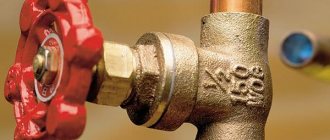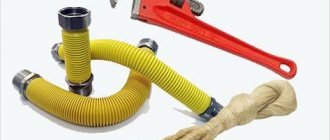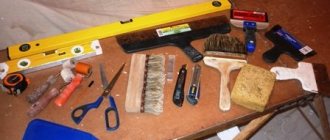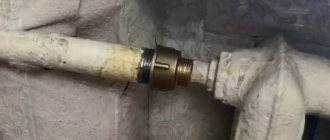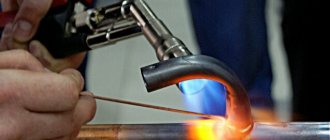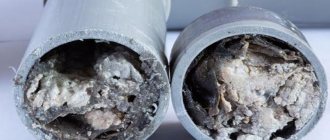Types of pipe connections
There are several main ways to connect gas pipes, or rather:
- Welding - carried out exclusively by specialists who have permission to work with a welding machine. Each employee must have a personal identification card.
- Threaded or fitting - also involves welding lightweight pipes, with the sockets sealed using hemp fiber. The whole process of work is very much reminiscent of connecting sewer pipes. It is worth noting that the fiber is pre-impregnated with a solution of linseed oil or drying oil. You can also use couplings that can have either long or short threads.
- Flange is one of the most common connection methods, as it has a fairly lightweight assembly design. However, according to experts, it is less reliable than welding.
All of the connection methods described above are used by professional craftsmen using specialized equipment.
In order to independently connect gas pipes in a house or apartment, you need to prepare the following tools and materials:
- gas adjustable wrench;
- tow and grease;
- hoses or pipe connections;
- if necessary, a connector with threads on both sides.
If you turned off the gas supply and purged the pipes, as recommended earlier, then the next step is to cut off unnecessary parts of the gas pipes. To do this, you can use a grinder, and if you don’t have one, then a hacksaw is quite suitable, but in this case the process will be lengthy and more complicated.
After you have removed the unnecessary part of the gas pipe, you need to carefully weld or solder one end of it.
If you need to connect one end of the pipe to a gas hose, you will need to cut a thread on the sawn part. To do this, there is a special nozzle, putting it on, you will need to scroll several times.
Next, tow is wound onto the thread made, which is soaked with lubricant and a connection is made to the hose. All this work is carried out using a gas adjustable wrench. If you plan to install a new pipe, you can use a special connecting adapter. This element has a ready-made thread on both sides and a nut that is screwed onto the main and new pipes.
This method can be used in apartments, you just need to make sure there are no leaks. To do this, you need to open the gas supply, then apply a soap solution to all pipe joints.
If you have never done such work yourself before, then it is best to entrust this matter to professionals.
Non-hardening pastes
Another suitable sealant for gas or other pipes is a special non-hardening paste in the form of a viscous substance based on synthetic resins, acrylic and silicone, oils and various fillers. Such products are very easy to use: they need to be applied to the threads and the pipes are connected.
Positive qualities of pastes:
- the presence of additives against metal rusting;
- quick and easy thread tightening;
- easy dismantling of the system;
- no thread jamming during assembly.
Unfortunately, such pastes are only suitable for pipes under low pressure. If the pressure is high, the composition will soon be squeezed out of the thread. You should also not rely on strong fixation of pipes, as well as on the resistance of the products to sudden changes in temperature or the effects of aggressive chemicals.
It is best to use non-hardening pastes with flax or artificial threads to increase the reliability of the joint.
Sealing of household air ducts
Ventilation in apartments and country houses is carried out using thin-walled elements. Often, air ducts are made of rectangular cross-section or from corrugated pipe. Threading on such connections is not possible. Therefore, sealing ventilation joints is carried out in other ways:
- through flanges,
- applying a bandage,
- using the socket method by inserting one air duct into another.
A flange connection is most often used for non-circular ducts. Sealing is carried out using gaskets made of soft material, for example, porous rubber. The shape of the gasket must match the cross-section of the air duct.
With other methods, the voids formed after joining the air ducts are filled with mastics whose temperature characteristics correspond to the operating conditions of the air line. Sometimes the joint of the air ducts is wrapped with self-adhesive tape.
Bandage clamps used for joining round air ducts
Application of FUM
FUM tapes and threads are used for sealing threaded connections of hot water supply (DHW), heating systems (CO) and cold water supply (CW). They are also used when connecting gas appliances to the gas pipeline.
Fluoroplastic is a plastic and strong material with a melting point above 400 degrees, resistant to oxygen and aggressive liquids. The thread and tape fill the unevenness of the thread and ensure sealing of the joint. FUM sealing tapes are produced with a width of 10-16 mm and a thickness of 0.08-0.12 mm, FUM threads with a diameter of 0.4-1.5 mm. With temperature changes and vibration, the FUMs are deformed and the threaded connection leaks.
The thickness of the tape winding depends on the diameter of the pipe and the thickness of the tape. For pipes with a diameter of up to 20 mm, 2-3 layers of tape with a thickness of 0.12 or 1-1.5 layers of thread are wound. For pipes with a diameter of up to 40 mm, 5-6 layers or 2-3 layers of thread are wound. For pipes with a diameter of over 40 mm, 8 or more layers of tape or 5 or more layers of thread are wound. For main pipelines, it is preferable to use tapes with silicone mastics.
If the thread is covered with rust, the winding thickness is doubled. Before winding the tape, the threaded connection is cleaned with an iron brush and blown with compressed air. The tape and thread are wound onto the pipe or fitting thread under tension with a force of 0.5-1 kg clockwise. To seal the threaded connections of gas appliances, they are wound counterclockwise.
Wind with a cone from the edge of the joint. If, after cleaning the rust, holes and damage are noticeable on the threads, use a different sealant. FUM is used to seal undamaged threaded connections.
Do not use FUM to seal heating pipes. Temperature changes will damage the FUM, the connection will leak, and water or steam leakage from the heating system will cause burns.
Is FUM tape used for sealing steam and water heating pipes? No, experienced plumbers seal such joints only with flax (tow) and sealant.
Universal sealing thread
Universal threads are an improved version of FUM tapes and are made from more modern materials. Usually these are nylon impregnated with sealant, polyamide with silicone. They can be used in pipes supplying natural gas, compressed air, as well as in water supply and sewerage systems, including on wet threads and at sub-zero air temperatures.
The most popular brands of threads are:
- "Record";
- Sprint;
- "Tangit Unilok";
- "Loctite 55".
Such threads are considered universal due to their ability to be used on metal and plastic, which is very important for modern gas pipeline systems. For these materials, the condition of the pipes is not important - they may even be rusty, old, or damaged.
After winding, the impregnated thread undergoes instant polymerization, and the connection can be put into operation immediately, without waiting time. This makes multi-purpose threads suitable for emergency repairs and emergencies.
Winding tape onto pipe threads
This operation is always performed using an external thread. If repairs are made by replacing the fitting, the pipe threads must be thoroughly cleaned of dirt and rust, degreased using acetone or white spirit, and dried in air for about 10 - 12 minutes. How to use a pipe burner to ensure its effectiveness:
- the seal must be wound onto the thread from its rear end;
- the FUM tape is applied in the direction of its descent, that is, its end should be located in the direction of screwing on the fitting;
- winding is carried out with tension, ensuring a tight fit of the pipe thread profile; it is better to allow the tape to break than to perform loose winding;
If there are no such notches, you need to do them yourself.
FUM tape for pipes is a modern and most commonly used means for sealing joints in pipelines for various purposes. FUM cord products that have appeared in recent years do not provide any special advantages either in application technology or in efficiency.
To understand how to use FUM tape for gas pipes, you need to take into account the characteristics of the material and apply it in the appropriate way.
Watch the video
Alternative materials – linen tow
Various seals are used, which include bast fibers in the form of strands and various sealants.
One of the first sealing materials to find widespread use in pipeline installation is tow. This is still the name given to flax fibers in the form of strands wound on the external thread of a pipe.
In this case, it is important to wind it carefully in turns, filling out the full cutting profile. For more reliable sealing, the winding of tow is covered with additional materials, from thickly rubbed paint to specially developed sealants
The advantages of sealing joints with plumbing tow are as follows:
- the ability to adjust the interface at its location - it is possible to turn the fitting in the opposite direction at an angle of up to 45 degrees without losing its insulating properties;
- sufficiently reliable tightness and ability to absorb moisture;
- the joint is resistant to mechanical stress;
- facilitated dismantling of the joint.
Disadvantages include the tendency to decompose as a result of putrefactive processes, since the material is an organic product.
Video
There is no clear answer to the question of choosing a method for sealing a threaded connection. The undoubted advantage of using tape is the connection of cantilever elements, such as taps or mixers; coupling connections of pipelines are best made with plumbing tow.
Sealants
Not only increases the impermeability of the connecting area, but also significantly increases its ability to withstand mechanical loads
Which is very important in pipeline systems due to constant vibration influences and water hammer
The sealant hardens upon contact with air or the mating surfaces of the threaded joint, acting as an adhesive and turning the assembly into a monolithic part.
The most common way of classification is by color and there are two main positions for this division:
- blue – represents medium strength sealants. Can significantly reduce the intensity of the thread loosening process. In practice, even the slightest weakening of a joint will require prolonged exposure to serious loads of an alternating nature. But when using blue sealants, it is still possible to turn the thread, although with great difficulty;
- When using red sealants, such an operation without heating does not seem realistic. This gel simply glues the structure together. For pipelines it is used in places with strong vibrations (from pumping equipment) and when water hammer is possible.
Conclusion
FUM tape for gas pipes is one of the main ways to seal joints during pipeline installation. The methods outlined here for how to use a paddle for gas pipes take into account all the main features of the material, but do not exclude the performer’s creative approach to this important operation. It is necessary to understand that the gas pipeline is a source of increased danger.
Video
Linen
Sealing threaded joints using flax thread is one of the oldest and most proven methods. Linen is sold in any plumbing store and markets.
When purchasing, be sure to pay attention to the following signs:
- elasticity of the thread;
- absence of garbage, unpleasant odor;
- small thickness of strands.
Linen in its pure form begins to quickly rot upon contact with water, with temperature changes, and in heating systems it completely burns out. In addition, the material does not help prevent rusting of metal pipes and fittings, unlike more modern sealants.
To level out these shortcomings, the thread is impregnated with special compounds (pastes). Thickly grated natural red lead is often used. The cheapest option is to make the paste yourself by taking whitewash and adding drying oil until you get a mass like sour cream. It is applied to the linen thread in a thin layer, smeared and dried.
Red lead is more suitable for working with steel pipes: it oxidizes the top layer of iron to an insoluble compound that does not allow oxygen to pass through, working like a bluing process. Stores also sell ready-made flax thread sealant pastes:
- Unipak (soap, chalk, paraffin, water, mineral oil).
- Multipak (paraffin oil with mineral additives).
- Pastum GAS (organic binders, special fillers, additives and anti-corrosion additives).
- Gebatout 2 (white mineral oil, thickener, synthetic polymer, mineral filler).
If the specified means are not at hand, for better sealing of gas connections, you can impregnate the flax with ordinary oil paint or automotive sealants.
The work is done as follows: a strand of flax 2 matches thick is separated from a common skein, wound onto the thread, starting from the far end and ending at the end of the pipe. After this, the flax is coated with paste, the joint is assembled (when twisting, force should be felt).
Fighting the leak
Fixing a heating system leak using a sealant is a chemical fight against leaks.
The specified German sealant proved to be excellent in solving this dilemma. The following tools are also used:
- Resins with two components based on epoxy.
- Adhesive silicone compounds.
- Heat-resistant compounds based on rubber.
Their algorithm:
- The damaged area is degreased, dried, and covered with a thin layer of sealant.
- Next, it is wrapped with serpyanka. Serpyanka reinforces the sealed layer.
- The serpyanka is already covered with sealant. The action is repeated.
If a silicone product is used, then you do not need to use abrasives to grind the damaged area. And this type of sealant adheres better to a smooth surface.
Welding of gas pipelines
Welding of gas pipes under pressure is carried out by highly qualified welders who have certificates for such work.
Manual arc welding and flash contact welding do not provide reliable corrosion resistance of the joint area
, only the pressure welding method eliminates these disadvantages.
Welding in a special welding installation occurs in this way: - the pipe is fed along the roller channels until it stops at the stopper of the immovable clamp and the pipe is clamped there. The supply of the second pipe is carried out until it stops at the first pipe, then the movable clamp is clamped; — a special mechanism regulates the difference between the edges and pre-pressure is created at the joint through a movable mechanism; — by longitudinal and transverse movement of the heating unit supports, the inductor is first adjusted to the junction and then closed; - turn on the induction heating source, and when the welding temperature is reached, the temporary relay will turn off the heating source; — the time allocated for welding one joint is no more than one minute; — a command is given for the upsetting of the welded pipes; after upsetting, the clamping devices are unclenched, the movable clamp returns to its initial position and the installation is ready to accept a new pipe.
This welding method is used in the gas industry to join ferrous pipes and pipes with an internal anti-corrosion coating.
Requirements for gas sealants
To completely eliminate gas leakage at the connecting points of the gas pipeline system, it is necessary that the winding meet the following requirements:
- resistance to vibrations of varying intensity;
- resistance to sudden changes in temperature and internal pressure;
- protection of the connection from the formation of corrosive deposits;
- ease of installation and dismantling in case of repairs;
- durability and long period of use.
All sealing materials must be tested by specialists for strength and certified for use in gas supply systems.
Solvent-based sealants
Such products undergo polymerization and completely harden some time after application. Curing occurs after the evaporation of the solvent present in the composition.
You can use sealants together with linen tape or on their own. Their advantages:
- serious level of fixation;
- strength and wear resistance of the seam;
- ease of installation of threaded connections;
- quick drying;
- low price.
Low quality materials may last slightly less, which is why the threads will have to be tightened periodically. If a thread gap that is too large is sealed with such a sealant, the seam will shrink over time.
Types and conditions of sealing
It is necessary to insulate joints when laying pipes for different types of pipelines. The only exception is welded joints, but this is their disadvantage - they are permanent. And joints using threads make it easy to replace a damaged area or insert a new harness.
Therefore, sealing is necessary for threaded pipe connections:
- hot and cold water supply,
- gas pipelines,
- heating.
In practice, threads are used in small-diameter pipelines - in internal wiring of houses and apartments, country cottages and when laying networks to detached buildings with low water and gas consumption. For large diameter water supply and heating pipes, flange connections and welding are used.
Ventilation lines, as a rule, have a large cross-section and are made of thin-walled sheets or corrugated pipes. Therefore, threaded connections are not used in them, but sealing the joints is still necessary.
When choosing a method for sealing pipe connections, it is necessary to take into account their properties and the conditions in which they will function:
- External temperature of the medium and internal temperature of the medium in the pipeline. Some types of sealants lose their properties at elevated temperatures or frost.
- Line pressure. Liquid insulators can be squeezed out of the connection under high pressure.
- Pipe diameter.
- The final strength of the connection. This is the force required to disassemble an insulated joint in case of repair or reassembly.
- Environmental Safety. When laying pipelines for drinking water, do not use substances that can release toxic compounds.
Most of the means and substances used for sealing, according to these parameters, fall within the range required for joining household pipelines. But a particularly careful choice is necessary when sealing gas pipe joints. Loss of tightness in water lines is noticeable from the very beginning by traces of leaks at the joints. Gas leaks are not visible and may remain undetected for a long time.
Features of installing an exhaust pipe for gas appliances
When installing gas heating appliances, as well as oil radiators, it is necessary to pay due attention to the issue of competent organization of the removal of combustion products from the premises. And this is correct, because, in addition to creating a safe environment for people, they increase the efficiency of the heating devices themselves, contributing to their more productive and economical operation
To determine the diameter of the gas outlet channel, it is necessary to take into account:
- Amount of combustion products.
- Power of heating devices.
- Temperature difference between outside air and combustion products.
- The height of the chimney pipe.
Installation of exhaust pipes for gas appliances, in accordance with the rules, is carried out next to internal walls and near partitions made of non-combustible materials. If necessary, it is also permitted to install them in external walls, also from non-combustible materials. In this case, in order to avoid the appearance of condensation when removing combustion products, the walls on the outside are insulated. If there is no wall in the room that is suitable for placing exhaust pipes in it, you need to use a root or attachment pipe for a gas appliance.
It is necessary to ensure maximum open access to the pipes.
Installation of gas appliances that do not have a connection to the chimney duct is carried out exclusively in a place where at least 5 m3 of free space will be allocated for each burner. A small water heater that is not equipped with exhaust gas combustion products must be allocated at least 6 m3. A gas water heater for a shower room or bathroom must have an exhaust hood for gas combustion products and a free space of at least 10 m3.
If the room where the gas stove is being installed does not have the required volume, then a ventilation outlet must be made above it. Since gas appliances use air from the room for combustion, it must be freely available. For this purpose, a small gap is left under the floor door (the area of the gap is calculated from the calculation: for every 1000 kcal/h of gas appliance power, at least 10 cm2 is required).
All heating devices, geysers, etc. are equipped with a fuse to shut off the gas if the fire goes out.
Installation of gas heating devices must always be carried out with a connection to the chimney in all cases except one: if it is a heater with a closed combustion chamber. Then the exhaust of combustion products and the air supply to the burner are separated from the room. A chimney with a cross-sectional area of 200-220 cm2 can be connected to a pair of gas appliances on one floor with a gas flow rate of 8 m3/hour. The height distance between the inlets into the chimney must be at least 30 cm. To connect four gas appliances from one apartment with a gas flow rate of 12 m3/h, on one floor you need a chimney with a cross-sectional area of at least 300 cm2. Connecting gas appliances to the same chimney on different floors is unacceptable.
The chimneys of gas appliances are located above the roof in the same way as conventional chimneys. When, during the reconstruction of a house, it is impossible to use the old chimney to remove gas combustion products from the stove, a new chimney is made from pipes that are connected to the rear facade of the house. These pipes are made of galvanized steel sheets, and, unlike pipes for removing combustion products of liquid and solid fuels, they are connected by joints that are directed in the opposite direction from the movement of gases.
During repairs or reconstruction, when the tightness of gas pipes may be compromised, it is necessary to check their integrity upon completion of the work. For this purpose, air is introduced into the pipes at a pressure that is twice the pressure that is necessary in them when gas passes through (approximately 500 mm of water column).
Before checking, you need to close the taps. If within five minutes the pressure in the pipes drops by more than 20 mm of water. Art., then you need to look for damage in the pipe (the suspected places of damage need to be moistened with soapy water). The gas pipeline for liquid gas is checked for leaks in the same way under a pressure of 1200 mm water. Art.
Threaded connections are applied to pipes, as well as connecting and branch fittings. But the simplicity and reliability of connecting any pipelines using threading still does not ensure its complete impermeability. Therefore, a mandatory addition is to seal the pipes at all points of threaded joints. Only this combination allows you to create a reliable connection.
How to seal connections in heating and water supply pipelines
On sale you can find many different materials that are designed to seal pipeline joints. The question arises: which material should be used in which cases? And also, how to properly use this or that seal?
It is often possible to use two or more thread sealants at once; then clarification is required as to which to prefer. The recommendations given should help to understand these issues and find a solution that will ensure sufficient reliability of the connection of pipes and threaded fittings for the entire period of operation.
Linen winding
Flax is a cheap material for threaded joints that creates a very high-quality seal. The only thing is that it cannot be used in all cases.
It is intended for connecting metal parts, as it creates significant density. It is very durable; the force applied by the keys to the two parts being connected is required to be significant.
Therefore, flax is not compacted:
- plastic parts - the tightening torque exceeds the strength of the material, the parts will be crushed and destroyed, at least the threads.
- parts in which a metal coupling with a thread is embedded in a plastic (polypropylene) shell, due to the danger of rotation (disconnection).
For all metal products, flax is the No. 1 material for winding threaded joints.
Next, let's look at how to apply it correctly.
Flax cannot be used “dry”; it must be lubricated with a special plumbing paste. It is applied either directly to the thread or to wound flax.
People's experience also suggests that sunflower oil can be used instead of paste, but the quality of the joint does not decrease, at least there is no such information.
A strand is separated from the flax and wound along a thread along each stream. Winding is done tightly and neatly. There should be no protruding hairs. The first two turns are not filled, but a shoulder is made at the end of the thread.
Special plumbing thread
A special thread for seals, of high strength (cannot be torn by hand), wound on spools, is sold in stores. Its main drawback is its high price, but otherwise it has solid advantages.
- It can be used on any parts, the tightening torque is less compared to flax, so you can also wrap plastic.
- It seals very well and can be used even on torn threads.
If it were not for the cost of this material, then only such plumbing thread would be used for joints.
Winding is carried out in exactly the same way as with flax - the first two turns of the thread are left empty so that the parts can be joined, and then winding is carried out along each thread of the thread, at the end of the winding - a double layer, i.e. shoulder
Fum tape
Fum tape is not suitable for creating reliable connections on pipelines. The material is not very durable; there is no sufficient density in the threaded connections of metal products with it. But for plastic connections that will be dismantled, for example, a summer pipeline for irrigation, fum tape is the most suitable sealant.
With fum tape, the parts to be joined can be wrapped by hand. In this case, a small density of the joint along the thread occurs, so that leaks do not occur for some time. A slight tightening force does not provide sufficient tightness and does not guarantee that the joint will not leak. For fixed connections, especially if they will be inaccessible during operation, it is recommended to use other materials.
Heating in the house can be done independently - the main installation issues
If the connection to the fum tape, which is already in operation, is turned, a leak will most likely occur. This is a serious drawback, considering that rotation does not require much effort.
At the household level, fum tape can be used (and is popular due to its low cost, ease of use, and low effort) for connections that are in plain sight - when connecting showers, taps, etc. Which heating scheme is best to use in a private house?
Plumbing adhesive sealant for threaded connections
The material is special, not exactly cheap, seals well, no cases of leakage have been recorded after its correct use. But only after the wrong...
The obvious disadvantage of sealant adhesive is that the quality of the joint will depend on the “human factor” more than with windings. The fact is that glue does not work well on oily surfaces.
Where do greasy surfaces come from? It could simply be carelessness - they dropped oil on the thread or rubbed the part in oil with their hands. Parts can be stored in a lubricated state (primarily steel ones). But the main thing is that a lubricant is used when cutting threads. After such an operation on steel parts, glue and sealant are completely unsuitable.
Please note that there are glue samples with which undocking the pipes requires heating of more than 100 degrees. Such heating is often difficult, not safe, plastic can be damaged, etc. Therefore, the adhesive-sealant is still selected according to the circumstances.
The glue is easy to apply. It is applied only immediately before joining, squeezed out of the tube onto the thread and smeared with your finger over the entire thread without skipping.
In what cases should you choose glue?
- When connecting plastic parts to metal ones, glue will be preferable. But such a connection does not occur often.
- The second case is when access to the docking site will be difficult. It is better to place such a connection with glue, and lubrication is carried out generously, without saving, on both parts being joined.
Read about the problems of soldering a polypropylene pipeline - how to do the installation correctly and reliably
Winding Features
Winding on threads requires great care. The thread must be filled in an even layer without gaps, and there must be sealing material in each groove. It is laid to the end of the thread, where a shoulder is formed from it.
The main tightening of threaded connections occurs on the last two threads. On parts, more often than not, the last two turns of the thread are not cut to the full depth. Therefore, in this place the material is wedged between the two parts very tightly.
It would be nice if, when carrying out work, you organize additional (cross-cut) quality control of the flax winding. This is especially true when several dozen similar connections are performed at once.
conclusions
- For those who are constantly engaged in installation, it is recommended to always have flax, plumbing thread and adhesive sealant with you in order to quickly and efficiently complete any connection. It is recommended to apply all this in accordance with the tips given above.
- When doing work at home with your own hands, when doing something simple and in plain sight, you can use cheap fum tape, but you need to wrap more. When installing entire systems with your own hands, it is better to use flax (with vegetable oil) on metal, and for small volumes of work it is even better to use thread. Maximum attention should be paid to the quality of winding on the thread.
What should never be used to seal threaded connections:
- There is no need to use simple silicone; it is designed for flange connections.
- There is no need to use paints, whitewash, or red lead, which are of little use, but make the connections semi-dismountable - this is long outdated.
Also read more about selecting the diameter of the pipeline for a heating system in a private house
Natural sealants
Jute and tow are used in conjunction with silicone sanitary sealants. The thread is cleaned of dirt and rust, coated with sealant, the sealant is twisted into a thread and wound clockwise flush with the thread crest. When winding, the seal is pulled with a force of 0.5-1 kg.
After winding, carefully coat with sealant and assemble the connection. Within 5-8 minutes, until the polymerization process is completed, it is necessary to check and, if necessary, tighten the connection further. Tightening the nut after the sealant has polymerized will cause leakage.
Stores sell ready-made plumbing thread for sealing pipes, made from flax. It doesn't need to be twisted. Before you buy a thread, read on the packaging what it is made of and whether it contains silicone or acrylic sealants. If it is a fluoroplastic thread, it is not advisable to use it on damaged threaded connections; if it is a vegetable thread without sealant, then purchase sanitary sealant separately.
Owners of apartments and houses ask: “Which thread is best for pipes?”, meaning the brand. To which a professional plumber will answer: “Better is the thread that was skillfully wound.”
If there is more or less thread than required, or it is not wound along the threads, the connection will leak. Do not wind it “with reserve”, wind it as much as necessary and do not forget about the sealant.
Anaerobic adhesive sealants
Anaerobically curing gel sealants are ideal for sealing metal threaded connections. They penetrate even the smallest cracks and gaps and undergo polymerization when contact with oxygen ceases. Under normal conditions, sealants remain liquid for a long time, but as they harden, they turn into a durable mass like plastic.
Using anaerobic sealant is very simple. It can be applied to the thread with a brush or squeezed out of a tube, then smeared and tightened. After 15–60 minutes, the joint will be completely sealed, but another day must pass before the gas equipment can be used. The most popular brands of anaerobic compounds are:
- "SantechMaster";
- Loctite 577;
- Loxeal 58;
- Unitec EASY.
Types of sealing tapes
This material is produced in the form of winding on a reel up to 10 meters long. Successfully used for winding onto pipe threads in pressure systems, including water, gas and heating systems.
Its purpose in connections is a deformable filler that acts as a thread lubricant, helping to increase tightness. This seal is available in 3 types:
- type 1 – for use in pipeline systems for transporting aggressive liquids, used using purified petroleum jelly;
- type 2 – for pumping strong oxidizing agents, which prohibits the use of additional sealant in the form of oils;
- type 3 – used for transporting relatively pure liquids and gases; the use of lubricants is excluded.
Plumbing thread
Sealing threads with plumbing thread
Plumbing thread is an excellent winding material for pipes with one drawback: its high price. It cannot be torn by hand and is suitable for sealing all threaded joints (even those that have a torn surface from a bad thread cutting tool). As for plastic parts, the tightening torque required when using threads is not the same as when using flax. Plumbing thread can be used for all parts.
Sealing threads with thread.
For those who are too lazy to twist flax into strands and then smear it with paste, they came up with a sealing thread. The thread can be made from different materials:
- Polyamide - designed for a pressure of 16 atmospheres on water and 8 atmospheres on gas, has an upper temperature threshold of 130° C.
- Fluoroplastic - has characteristics identical to FUM tape, but usually costs more.
Manufacturers lubricate the thread with a special lubricant, the composition of which they do not disclose. In my opinion, fluoroplastic thread is better in quality and I recommend it to you, despite the fact that it is more expensive than polyamide thread. If you want to learn how to wind thread correctly, watch the following video:
—
CONDITION 1
| RESULTS. â |
RESULTS RESULTS RESULTS. RESULTS ÑÐ±Ñ Ð¸ нанеÑÐµÐ½Ð¸Ñ Ð±Ð¸ÑÑмнÑÑ Ñлоев ÑовмеÑÐµÐ½Ñ Ð¸ Ð ²ÑполнÑÑÑÑÑ Ð½Ð° одной ÑÑÑÑÐ °Ð½Ð¾Ð²ÐºÐµ, ÑазмеÑаемой в конÑе поÑоÑной лиР½Ð¸Ð¸. â
| RESULTS. â |
RESULTS RESULTS ASSURANCE RESULTS. â
| RESPONSIBILITY, RESULTS °ÑÑка газо. â |
RESULTS, RESULTS ÑопиÑанной клеем. RESULTS RESULTS ¿Ð»Ð°ÑÑиковÑÑ Ð¾Ð± олоÑкÑ-бандаж. ROOM давлениÑ. â
RESULTS ¸Ð·Ð¾Ð»ÑÑионнÑм маÑеÑиалом. RESULTS. â
| RESULTS. â |
RESULTS s ROOM CONTENTS, CONDITIONS линии. â
| RESULTS. â |
ROOM CONTENTS , , , , , , , , ¾Ð»Ð¾Ñки; RESULTS OPTIONS . ROOM ROOM . â
RESPONSIBILITY ss, ss RESULTS CONCLUSION: 1) ROLLING UP, LOCKING ´Ð½Ð°Ð· наÑеннÑÑ Ðº гÑммиÑованиÑ; 2) RESEARCH, CONDITION; 3) RESULTS ROOM из ÑаолиÑа; 4) RESULTS з ÑекÑÑоѰолиÑа и дÑ. RESULTS, RESEARCHES ÑÑ ÑÑанение вÑÐµÑ ÑÑÐ¸Ñ Ð²ÐµÑеÑÑв. â
RESULTS RESULTS RESULTS. RESULTS ÑÐ±Ñ Ð¸ нанеÑÐµÐ½Ð¸Ñ Ð±Ð¸ÑÑмнÑÑ Ñлоев ÑовмеÑÐµÐ½Ñ Ð¸ Ð ²ÑполнÑÑÑÑÑ Ð½Ð° одной ÑÑÑÑÐ °Ð½Ð¾Ð²ÐºÐµ, ÑазмеÑаемой в конÑе поÑоÑной лиР½Ð¸Ð¸. â
| RESULTS. â |
→ RESULTS RESULTS RESEARCH Ñой, п ÑопиÑанной ÑпокÑиднÑм клеем. RESULTS RUR 50 RUR °Ñи и вÑÑе. RESULTS оÑиÑаÑÑ. â
